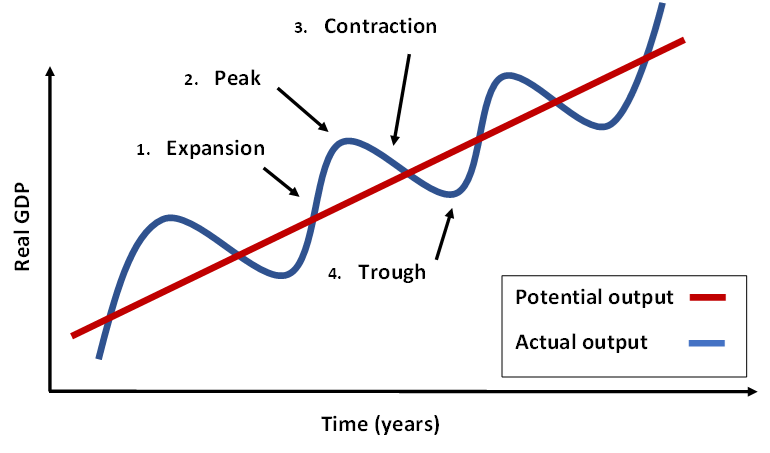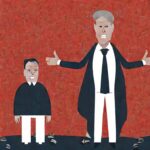The business cycle, as shown below, refers to the observed pattern of expansions and contractions which economies routinely follow over time. They are separated into four distinct phases:
- Expansion – the economy is growing rapidly, unemployment is falling and inflation is rising
- Peak – economic output has reached a new high in the cycle, unemployment is very low, and inflation is rising rapidly
- Contraction – the economy is shrinking, unemployment is rising, and inflation is low
- Trough – the economy has reached a new low in the cycle, unemployment is very high, and inflation is very low or possibly negative

The end of the trough phase provides new opportunities for businesses to expand, which leads to the next expansion phase in the business cycle.
Potential output
The red trend line indicates the level of potential output for an economy. This is the level of output where the economy has reached full employment. Although the term ‘full employment’ seems to indicate that all resources in the economy are fully utilized, this is not actually the case. A small percentage of resources remain unemployed, which economists refer to as the natural rate of unemployment.
Note that the natural rate of unemployment varies across different economies and different time periods, but for the sake of simplicity can be stated to hover around unemployment of 2-4% of the labour force.
Actual output
The blue line indicates the actual output in the economy. Similar to the production point discussed in the production possibility frontier (PPF) model, the actual output shows the level of output which is actually being produced. As such it is actual output which undergoes the four phases of the business cycle.
During the peak phase of the business cycle the economy is above full employment. This is possible because even at full unemployment, there are still some unused resources which are yet to be fully utilized. During the trough the economy is below full employment, which indicates that the unemployment rate is higher than the natural rate of unemployment.
Author Profile

- Luke Watson has a BSc (Hons) in international business and economics. He is currently working as an IBDP economics teacher at Shanghai United International School in China.
Latest entries
- March 10, 2023CourseHow the Fed Sets Interest Rates Post-Crisis
- February 5, 2023CourseHow to Calculate the Gini Coefficient Using the Lorenz Curve
- January 29, 2023CourseHow to Score Full Marks on the Economics IA
- January 29, 2023CourseHow to Effectively Structure Your Economics IA





Comments are closed